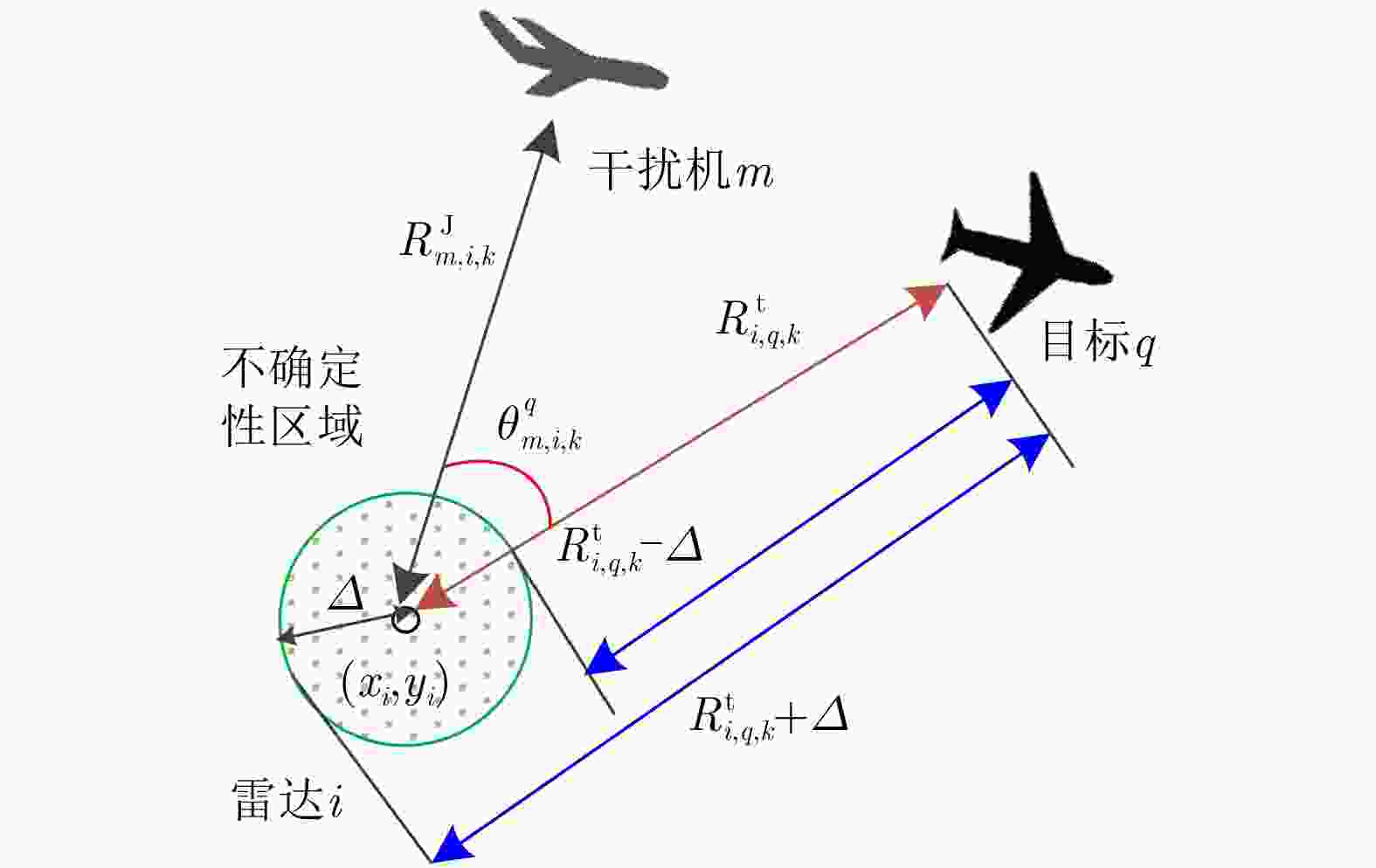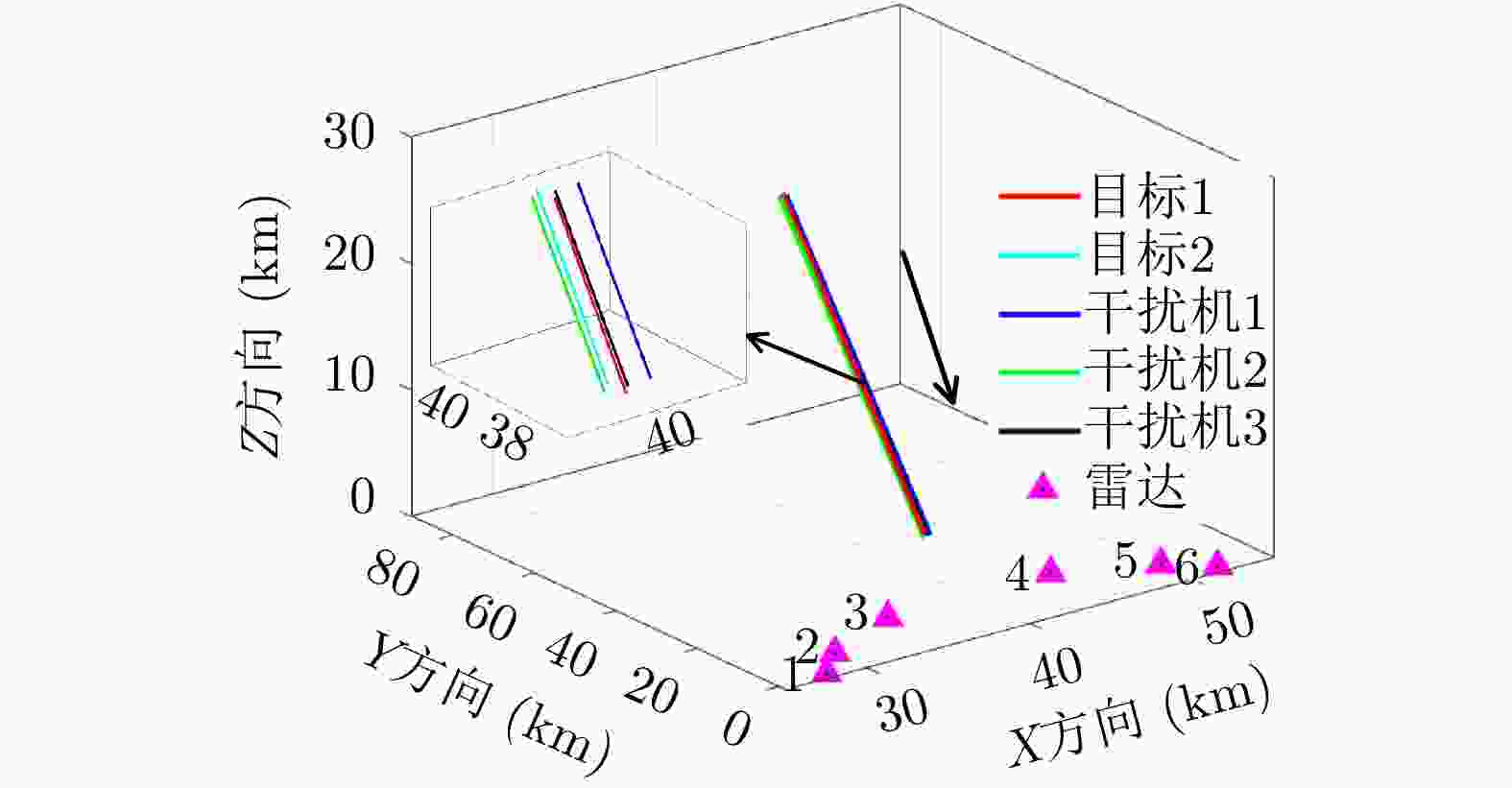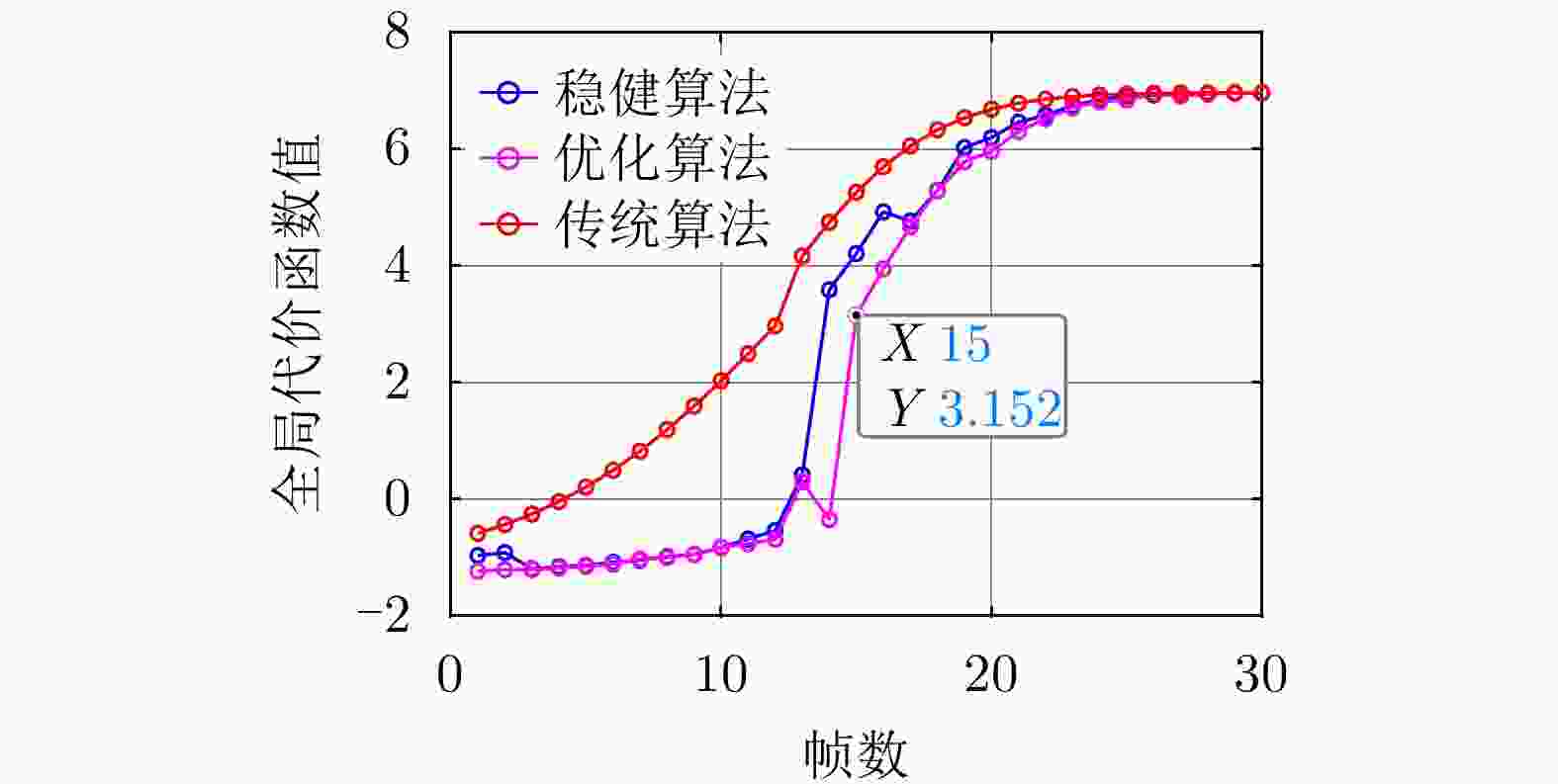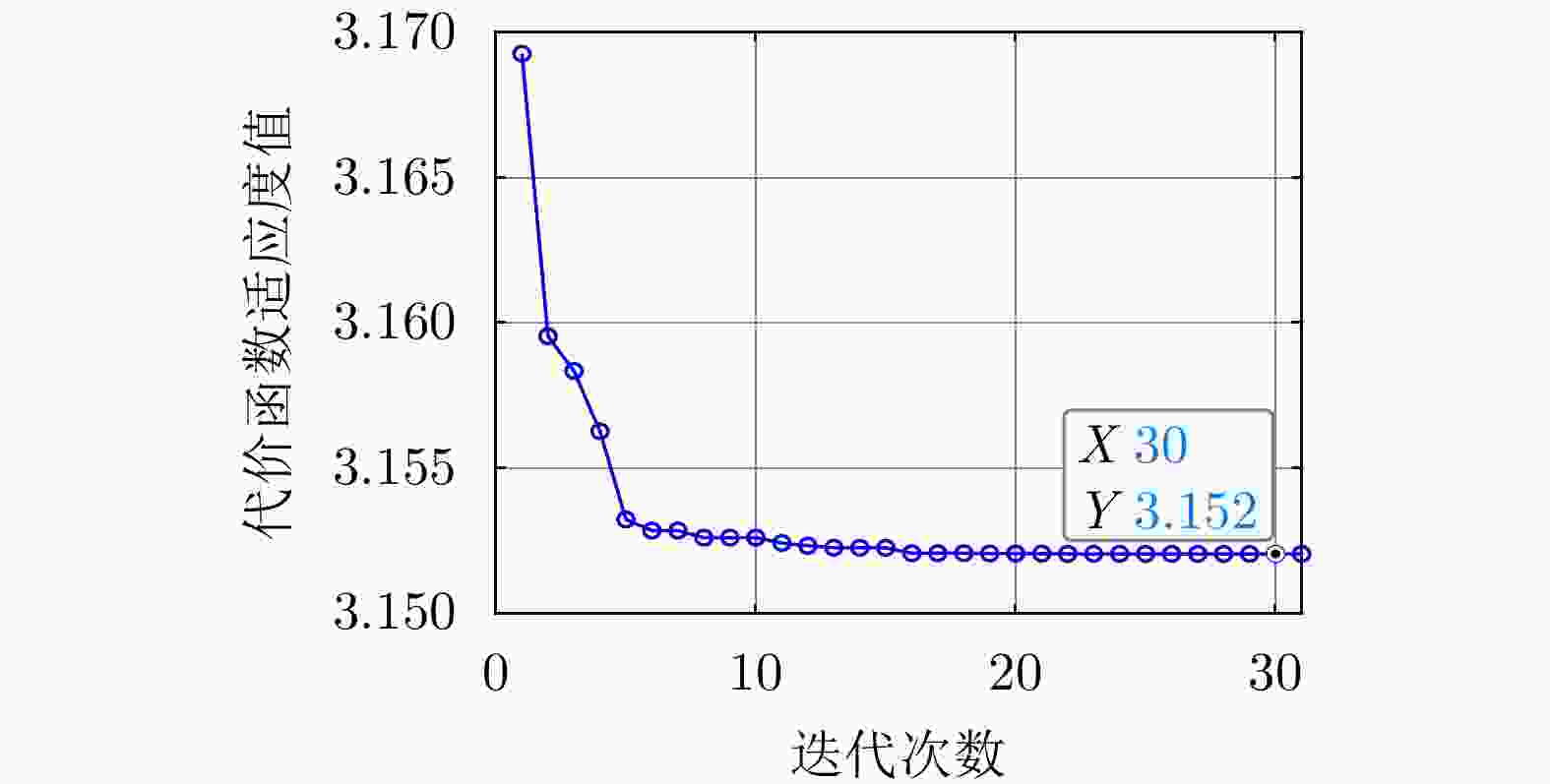-
摘要: 针对多目标突防组网雷达系统(NRS)场景,该文提出一种面向组网雷达干扰任务的多干扰机资源联合优化分配方法。首先,采用组网雷达在干扰环境中对目标的检测概率作为干扰性能指标;然后,结合不同突防目标的检测性能需求,建立了包含干扰波束和发射功率2个优化变量的资源优化模型,并利用粒子群算法对资源优化问题进行求解;最后,考虑到组网雷达系统参数不确定性带来的检测概率泛化误差,建立了干扰资源稳健优化分配模型。仿真结果表明,该文提出的优化方法能有效压制组网雷达,降低组网雷达对突防目标的检测概率;相比传统方法,稳健方法提升了多干扰机对组网雷达的协同干扰性能,且具有鲁棒性。Abstract: An optimal joint allocation of multijammer resources is proposed for jamming a Netted Radar System (NRS) in the case of multitarget penetration. First, the multitarget detection probabilities of NRS in the suppressive jamming environment are used as an interference performance metric. Then, the resource optimization model is established, including two optimization variables, namely, jamming beam and transmitting power, considering the detection performance requirements of different targets. Particle swarm optimization is used to solve the resource-optimization problem. Finally, considering the generalization error of the detection probability caused by the parameter uncertainty of the NRS, the robust resource-optimization model is established. The simulation results show that the proposed optimization model is effective in suppressing the NRS and reducing the probability of the penetrating targets detected by the NRS. Compared with the traditional method, the robust algorithm improves the cooperative interference performance of multiple jammers against NRS and is robust.
-
表 1 不同融合准则下的组网雷达检测概率
Table 1. The detection probability of the NRS with different fusion rules
融合准则 检测概率 AND准则($K = N$) ${\rm{Pd} }_k^q = {\displaystyle\prod\limits_{i = 1}^N } {\rm{Pd} }_{i,k}^q$ OR准则($K = 1$) ${\rm{Pd} }_k^q = 1 - \displaystyle\prod \limits^N_{i = 1} (1 - {\rm{Pd} }_{i,k}^q)$ 秩K准则 ${\rm{Pd} }_k^q = \displaystyle\sum\limits_{j = K}^N {\left\{ {\sum\limits_{\forall \left\{ {\sum {v_{i,k}^q = j} } \right\} } {\mathop \prod \limits_i { {({\rm{Pd} }_{i,k}^q)}^{v_{i,k}^q} }{ {(1 - {\rm{Pd} }_{i,k}^q)}^{1 - v_{i,k}^q} } } } \right\} }$ 表 2 基于PSO的波束指向
$\boldsymbol{u}_k^{{\rm{opt}}}$ 求解方法Table 2. The solution algorithm of the beam selection
$\boldsymbol{u}_k^{{\rm{opt}}}$ based on PSO步骤1 初始化$\boldsymbol{P}_k^{{\rm{uni}}}$, $\boldsymbol{u}_k^{{\rm{opt}}}{\rm{ = }}{{\bf{0}}_{M \times N}}$, $\boldsymbol{u}_k^{{\rm{con}}} \in [0,1]$; 步骤2 PSO求解式(32),得到松弛结果$\boldsymbol{u}_{k,{\rm{opt}}}^{{\rm{con}}}$; 步骤3 循环$l = 1, 2,··· ,L \times M$
寻找最大值$[{m_l},{i_l}] = \arg \;\max \{ \boldsymbol{u}_{k,{\rm{opt}}}^{{\rm{con}}}\} $;
更新$\boldsymbol{u}_k^{{\rm{opt}}}({m_l},{i_l}) = 1$,且$\boldsymbol{u}_{k,{\rm{opt}}}^{{\rm{con}}}({m_l},{i_l}) = 0$;
判断$\boldsymbol{u}_k^{{\rm{opt}}}$是否满足式(2)—式(4)的约束条件,若不满足则
$\boldsymbol{u}_k^{{\rm{opt}}}({m_l},{i_l}) = 0$;
循环结束步骤4 输出波束指向结果$\boldsymbol{u}_k^{{\rm{opt}}}$。 表 3 干扰机工作参数
Table 3. The working parameters of the jammer
参数 数值 干扰机总功率$P_m^{{\rm{total}}}$ 130 W 波束个数L 2 天线增益$G_m^{\rm{J}}$ 10 dB 极化失配损失${\gamma ^{\rm{J}}}$ 0.5 工作波长${\lambda _{\rm{f}}}$ 0.1 m 天线波瓣宽度${\theta _{0.5}}$ 3° 表 4 雷达工作参数
Table 4. The working parameters of the radar node
参数 数值 发射功率$P_i^{\rm{t}}$ 200 MW 最多被干扰波束个数$S$ 1 发射天线增益$G_i^{\rm{t}}$ 40 dB 虚警概率 10–6 工作波长${\lambda _{\rm{f}}}$ 0.1 m -
[1] 张养瑞, 高梅国, 罗皓月, 等. 基于检测概率的雷达网协同干扰效果评估方法[J]. 系统工程与电子技术, 2015, 37(8): 1778–1786. doi: 10.3969/j.issn.1001-506X.2015.08.10ZHANG Yangrui, GAO Meiguo, LUO Haoyue, et al. Evaluation method of cooperative jamming effect on radar net based on detection probability[J]. Systems Engineering and Electronics, 2015, 37(8): 1778–1786. doi: 10.3969/j.issn.1001-506X.2015.08.10 [2] ZHENG Gaoqian and ZHENG Ying. Radar netting technology & its development[C]. 2011 IEEE CIE International Conference on Radar, Chengdu, China, 2011: 933–937. doi: 10.1109/CIE-Radar.2011.6159694. [3] 时晨光, 汪飞, 周建江, 等. 基于低截获概率优化的雷达组网系统最优功率分配算法[J]. 雷达学报, 2014, 3(4): 465–473. doi: 10.3724/SP.J.1300.2014.13140SHI Chenguang, WANG Fei, ZHOU Jianjiang, et al. Optimal power allocation algorithm for radar network systems based on low probability of intercept optimization[J]. Journal of Radars, 2014, 3(4): 465–473. doi: 10.3724/SP.J.1300.2014.13140 [4] MA Jianming, LIU Yintong, and CHEN Guang. New jamming method of netted radar based on time synchronization errors[C]. 2019 International Conference on Information Technology, Electrical and Electronic Engineering, Sanya, China, 2019: 452–456. doi: 10.12783/dtcse/iteee2019/28787. [5] 段先华, 孙庆国, 蔡丹. 基于改进遗传算法的协同干扰资源优化分配[J]. 江苏科技大学学报: 自然科学版, 2016, 30(5): 466–472. doi: 10.3969/j.issn.1673-4807.2016.05.011DUAN Xianhua, SUN Qingguo, and CAI Dan. Optimization assignment for cooperative jamming resources based on improved genetic algorithms[J]. Journal of Jiangsu University of Science and Technology:Natural Science Edition, 2016, 30(5): 466–472. doi: 10.3969/j.issn.1673-4807.2016.05.011 [6] 张养瑞, 李云杰, 高梅国. 协同干扰资源优化分配模型及算法[J]. 系统工程与电子技术, 2014, 36(9): 1744–1749. doi: 10.3969/j.issn.1001-506X.2014.09.12ZHANG Yangrui, LI Yunjie, and GAO Meiguo. Optimal assignment model and solution of cooperative jamming resources[J]. Systems Engineering and Electronics, 2014, 36(9): 1744–1749. doi: 10.3969/j.issn.1001-506X.2014.09.12 [7] 黄郡, 单洪, 沈楠. 协同干扰节点资源优化分配模型及算法[J]. 计算机应用研究, 2011, 28(8): 2912–2914. doi: 10.3969/j.issn.1001-3695.2011.08.031HUANG Jun, SHAN Hong, and SHEN Nan. Optimal assignment model and solution of coordinated jamming nodes[J]. Application Research of Computers, 2011, 28(8): 2912–2914. doi: 10.3969/j.issn.1001-3695.2011.08.031 [8] 谯梁, 杨帅, 王鑫, 等. 雷达干扰效果评估与协同干扰策略分配算法研究[J]. 航天电子对抗, 2019, 35(3): 27–32. doi: 10.3969/j.issn.1673-2421.2019.03.007QIAO Liang, YANG Shuai, WANG Xin, et al. Effect evaluation of radar interference and cooperative interference strategy allocation algorithm[J]. Aerospace Electronic Warfare, 2019, 35(3): 27–32. doi: 10.3969/j.issn.1673-2421.2019.03.007 [9] 孙伯明, 梁修华, 吴付祥. 多波束雷达干扰机作战效能分析[J]. 舰船电子对抗, 2007, 30(5): 40–42. doi: 10.16426/j.cnki.jcdzdk.2007.05.025SUN Boming, LIANG Xiuhua, and WU Fuxiang. Operation effectiveness analysis of multi-beam radar jammer[J]. Shipboard Electronic Countermeasure, 2007, 30(5): 40–42. doi: 10.16426/j.cnki.jcdzdk.2007.05.025 [10] 韩剑, 张杰. 多波束及其在无人机上的应用[J]. 航天电子对抗, 2014, 30(2): 47–50. doi: 10.3969/j.issn.1673-2421.2014.02.014HAN Jian and ZHANG Jie. Multi-beam technology and applications to UAV[J]. Aerospace Electronic Warfare, 2014, 30(2): 47–50. doi: 10.3969/j.issn.1673-2421.2014.02.014 [11] 李光明, 田孝华, 刘潇, 等. 智能多波束干扰技术研究[J]. 电光与控制, 2017, 24(4): 1–4.LI Guangming, TIAN Xiaohua, LIU Xiao, et al. On multi-beam jamming technology based on array antenna[J]. Electronics Optics &Control, 2017, 24(4): 1–4. [12] LUO Zhaoyi, DENG Min, YAO Zhiqiang, et al. Distributed blanket jamming resource scheduling for satellite navigation based on particle swarm optimization and genetic algorithm[C]. The 2020 IEEE 20th International Conference on Communication Technology, Nanning, China, 2020: 611–616. doi: 10.1109/ICCT50939.2020.9295811. [13] 李昌锦, 陈永光, 沈阳, 等. 突防过程的组网雷达干扰资源优化分配[J]. 火力与指挥控制, 2006, 31(10): 8–10, 25. doi: 10.3969/j.issn.1002-0640.2006.10.003LI Changjin, CHEN Yongguang, SHEN Yang, et al. On study of optimum allocation for jamming resource against netted radar based on penetrating process[J]. Fire Control and Command Control, 2006, 31(10): 8–10, 25. doi: 10.3969/j.issn.1002-0640.2006.10.003 [14] 沈阳, 陈永光, 李修和. 基于0-1规划的雷达干扰资源优化分配研究[J]. 兵工学报, 2007, 28(5): 528–532. doi: 10.3321/j.issn:1000-1093.2007.05.005SHEN Yang, CHEN Yongguang, and LI Xiuhe. Research on optimal distribution of radar jamming resource based on zero-one programming[J]. Acta Armamentarii, 2007, 28(5): 528–532. doi: 10.3321/j.issn:1000-1093.2007.05.005 [15] 戴少怀, 杨革文, 李旻, 等. 改进粒子群算法的组网雷达协同干扰资源分配[J]. 航天电子对抗, 2020, 36(4): 29–34, 45. doi: 10.3969/j.issn.1673-2421.2020.04.007DAI Shaohuai, YANG Gewen, LI Min, et al. Cooperative jamming resources allocation of networked radar based on improved particle swarm optimization algorithm[J]. Aerospace Electronic Warfare, 2020, 36(4): 29–34, 45. doi: 10.3969/j.issn.1673-2421.2020.04.007 [16] 陈奕琪. 改进群智能算法多目标干扰决策[J]. 现代防御技术, 2020, 48(1): 107–112. doi: 10.3969/j.issn.1009-086x.2020.01.017CHEN Yiqi. Improved swarm intelligence algorithm for multi-objective jamming decision[J]. Modern Defence Technology, 2020, 48(1): 107–112. doi: 10.3969/j.issn.1009-086x.2020.01.017 [17] 郭小一, 袁卫卫, 黄金才. 雷达干扰资源一对多分配方法[J]. 火力与指挥控制, 2008, 33(12): 22–25, 29. doi: 10.3969/j.issn.1002-0640.2008.12.006GUO Xiaoyi, YUAN Weiwei, and HUANG Jincai. Research on method of radar jamming resource distribution based on one-jammer to multi-radar[J]. Fire Control and Command Control, 2008, 33(12): 22–25, 29. doi: 10.3969/j.issn.1002-0640.2008.12.006 [18] 高晓光, 胡明, 郑景嵩. 突防任务中的单机对多目标干扰决策[J]. 系统工程与电子技术, 2010, 32(6): 1239–1243. doi: 10.3969/j.issn.1001-506X.2010.06.028GAO Xiaoguang, HU Ming, and ZHENG Jingsong. Jamming strategy for single plane to multi-target in task of penetration[J]. Systems Engineering and Electronics, 2010, 32(6): 1239–1243. doi: 10.3969/j.issn.1001-506X.2010.06.028 [19] 崔哲铭, 彭世蕤, 任明秋, 等. 基于波束数量控制的多波束干扰资源调度研究[J]. 空军预警学院学报, 2020, 34(4): 274–278. doi: 10.3969/j.issn.2095-5839.2020.04.009CUI Zheming, PENG Shirui, REN Mingqiu, et al. Research on multi-beam interference resource scheduling based on beam quantity control[J]. Journal of Air Force Early Warning Academy, 2020, 34(4): 274–278. doi: 10.3969/j.issn.2095-5839.2020.04.009 [20] 张政超, 徐裴为, 李文臣, 等. 复杂电磁干扰下组网雷达检测概率研究[J]. 中国电子科学研究院学报, 2014, 9(4): 391–395. doi: 10.3969/j.issn.1673-5692.2014.04.013ZHANG Zhengchao, XU Peiwei, LI Wenchen, et al. Research on detected probability of radar network under complex electromagnetism jamming[J]. Journal of CAEIT, 2014, 9(4): 391–395. doi: 10.3969/j.issn.1673-5692.2014.04.013 [21] 王红军, 赵宏. 噪声干扰条件下雷达检测概率的评估[J]. 火力与指挥控制, 2003, 28(1): 40–42. doi: 10.3969/j.issn.1002-0640.2003.01.010WANG Hongjun and ZHAO Hong. Evalution of the radar detecting probability under noise jamming[J]. Fire Control & Command Control, 2003, 28(1): 40–42. doi: 10.3969/j.issn.1002-0640.2003.01.010 [22] 周怀军, 丁士援. 噪声干扰条件下雷达检测概率分析[J]. 舰船电子对抗, 2007, 30(6): 43–45. doi: 10.16426/j.cnki.jcdzdk.2007.06.007ZHOU Huaijun and DING Shiyuan. Analysis of radar detection probability under the noise jamming condition[J]. Shipboard Electronic Countermeasure, 2007, 30(6): 43–45. doi: 10.16426/j.cnki.jcdzdk.2007.06.007 [23] JIANG Haiqing, ZHANG Yangrui, and XU Hongyi. Optimal allocation of cooperative jamming resource based on hybrid quantum-behaved particle swarm optimisation and genetic algorithm[J]. IET Radar, Sonar & Navigation, 2017, 11(1): 185–192. doi: 10.1049/iet-rsn.2016.0119 [24] 胡新宇, 张铁军, 王昀. 低截获概率雷达信号侦察技术[J]. 航天电子对抗, 2020, 36(5): 40–43. doi: 10.16328/j.htdz8511.2020.05.009HU Xinyu, ZHANG Tiejun, and WANG Yun. Low probability of intercept radar signal reconnaissance technology[J]. Aerospace Electronic Warfare, 2020, 36(5): 40–43. doi: 10.16328/j.htdz8511.2020.05.009 [25] MA Jing, SHI Bin, CHE Fei, et al. Research on evaluation method of cooperative jamming effect in cognitive confrontation[C]. The 1st International Conference on Artificial Intelligence for Communications and Networks, Harbin, China, 2019: 40–51. [26] ZHANG Lin, SHI Guoqing, and GENG Xiutang. Blanket jamming targets assignment based on adaptive genetic algorithm[C]. 2019 IEEE International Conference on Cybernetics and Intelligent Systems (CIS) and IEEE Conference on Robotics, Automation and Mechatronics (RAM), Bangkok, Thailand, 2019: 171–175. doi: 10.1109/CIS-RAM47153.2019.9095841. [27] SHEN Tongyun, DING Jianjiang, DING Yuan, et al. A method of detection performance modeling in jamming condition based on radar network system[C]. 2011 IEEE CIE International Conference on Radar, Chengdu, China, 2011: 1366–1369. doi: 10.1109/CIE-Radar.2011.6159812. [28] ZHANG Huan, YANG Rennong, SUN Changyue, et al. Research on multiaircraft cooperative suppression interference array based on an improved multiobjective particle swarm optimization algorithm[J]. Mathematical Problems in Engineering, 2017, 2017: 9843735. doi: 10.1155/2017/9843735 [29] 马哈夫扎, 挨尔舍贝利, 朱国富, 黄晓涛, 黎向阳, 等译. 雷达系统设计MATLAB仿真[M]. 北京: 电子工业出版社, 2009.MAHAFZA B R, ELSHERBENI A Z, ZHU Guofu, HUANG Xiaotao, LI Xiangyang, et al. translation. MATLAB Simulations for Radar Systems Design[M]. Beijing: Publishing House of Electronics Industry, 2009. [30] LIU Weijian, WANG Yongliang, LIU Jun, et al. Performance analysis of adaptive detectors for point targets in subspace interference and gaussian noise[J]. IEEE Transactions on Aerospace and Electronic Systems, 2018, 54(1): 429–441. doi: 10.1109/TAES.2017.2760718 [31] 韩国玺, 何俊, 祁建清. 基于秩K准则的网络雷达对抗系统融合发现概率计算模型[J]. 海军工程大学学报, 2014, 26(1): 64–70.HAN Guoxi, HE Jun, and QI Jianqing. Fused detection probability model of NRCS based on rank K criterion[J]. Journal of Naval University of Engineering, 2014, 26(1): 64–70. [32] 王国良, 申绪涧, 汪连栋, 等. 基于秩K融合规则的组网雷达系统干扰效果评估[J]. 系统仿真学报, 2009, 21(23): 7678–7680.WANG Guoliang, SHEN Xujian, WANG Liandong, et al. Effect evaluation for noise blanket jamming against netted radars based on rank-K information fusion rules[J]. Journal of System Simulation, 2009, 21(23): 7678–7680. [33] YI Wei, YUAN Ye, HOSEINNEZHAD R, et al. Resource scheduling for distributed multi-target tracking in netted colocated MIMO radar systems[J]. IEEE Transactions on Signal Processing, 2020, 68: 1602–1617. doi: 10.1109/TSP.2020.2976587 [34] YAN Junkun, LIU Hongwei, JIU Bo, et al. Simultaneous multibeam resource allocation scheme for multiple target tracking[J]. IEEE Transactions on Signal Processing, 2015, 63(12): 3110–3122. doi: 10.1109/TSP.2015.2417504 [35] YAN Junkun, LIU Hongwei, PU Wenqiang, et al. Joint beam selection and power allocation for multiple target tracking in netted colocated MIMO radar system[J]. IEEE Transactions on Signal Processing, 2016, 64(24): 6417–6427. doi: 10.1109/TSP.2016.2607147 -



 作者中心
作者中心 专家审稿
专家审稿 责编办公
责编办公 编辑办公
编辑办公

 下载:
下载:














